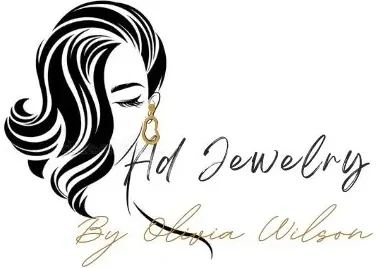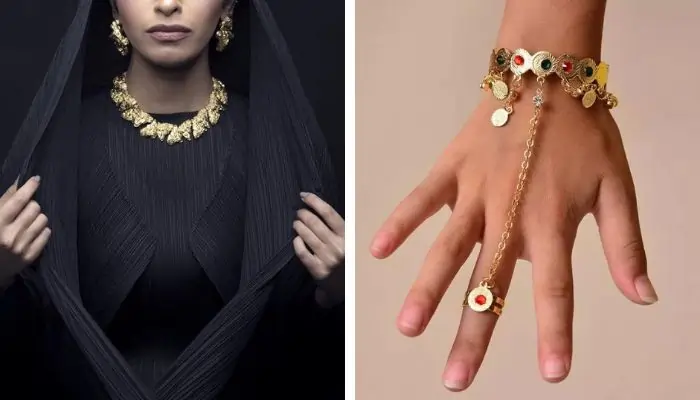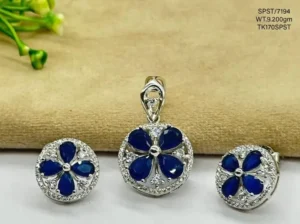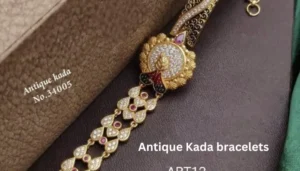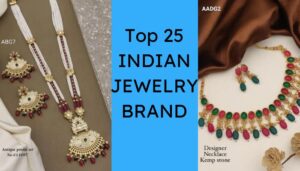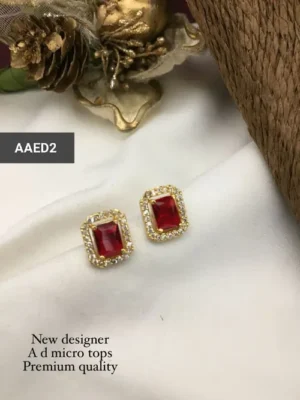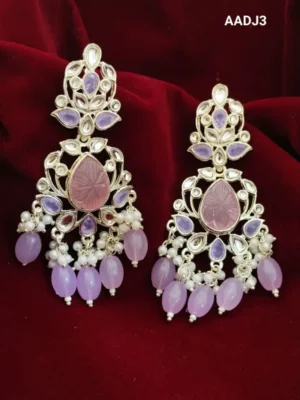Thousands of years ago, Middle Eastern jewelry was interesting. One of the oldest pearl and gold earrings ever unearthed was recovered by Bahraini archaeologists more than 4,000 years ago.
Traditions “Arabic jewellery” or “Middle Eastern jewelry” are known for their elaborate patterns and exquisite workmanship.
Middle Eastern jewellery’s rich history and effect on present fashion will be discussed in this blog article.
Jewelry History of the Middle East
Bahrain’s pearl and gold earring, believed to be 4,000 years old, is one of the oldest pieces of jewelry ever recovered.
Since jewellery-making has been part of Middle Eastern society for thousands of years, this discovery highlights its complexity.
Early jewelry was largely copper with shell or bone accents. More materials and processes became mainstream as civilization and commerce evolved.
Popular materials include silver and gold, and jewelry includes face jewelry, traditional Islamic jewelry, necklaces, and pendants.
Arab jewelry is generally embellished with valuable stones, like blue stones, and elaborate designs that symbolize Muslim culture.
Mestige, Majda Bekkali, and Amalgamation Jewels make exquisite Middle Eastern jewelry. Artists utilize enameling, filigree, engraving, and granulation to create masterpieces.
READ MORE – How to Wear a Pearl Necklace – A Beginner’s Guide
Arabic jewelry designers employ these methods to produce amazing designs.
The crescent moon pendant and other Muslim ornaments have spiritual meanings. In Islam, “Taweez” pendants guard against evil omens.
Middle Eastern jewelry is distinctive for its symbolism and artistry. It will remain influential in Arab culture for years.
Important Islamic jewelry-making techniques
Classical Islamic jewelry-making processes were complicated and intriguing. Encrustation with semi-precious and valuable stones, filigree, and niello were fashionable.
Crescent-shaped pendants were employed in Islamic culture as well as in Hellenistic civilization.
Ancient manuscript pictures have helped historians comprehend Middle Eastern jewelry from the 14th century forward.
In royal circles, Mongol and Timurid ladies wore diamond coiffures, while men wore diamond headdresses.
Islamic jewelry grew increasingly complex and dazzling during the Afavid era. Continuing styles were seen in Znjanb and among Kurdish mountaineers in northwest Iran.
Middle Eastern Jewelry Future
As the globe changes, so do Middle Eastern traditions. While traditional Islamic jewelry remains popular, modern creations are emerging.
By combining traditional and modern trends, one can create unique designs. Nowadays, many individuals buy antique clothes.
Buying a 1950s necklace or an 1800s bracelet gives them something distinctive they may love for years.
New Middle Eastern jewellery is also emerging. Colorful jewels, distinctive forms, and elaborate craftsmanship are in more designs. Titanium and stainless steel are increasing in popularity.
3D printing and CAD allow designers to make practically anything. This lets them make unique products for their clients.
Jewelry materials from the Middle East
Beautiful Middle Eastern jewelry was made from gold, silver, and copper. Gold, wire, granulated, and filigree jewelry were the most popular.
Silver was desirable because of its malleability, which made elaborate patterns possible. Most people selected copper for its toughness and tarnishing resistance. Stones and metals were utilized to make Middle Eastern jewelry.
Lots of civilizations valued lapis lazuli and turquoise. Religious emblems like the crescent moon and star were prominent in Islamic jewelry.
Some civilizations liked Middle Eastern facial jewelry. Islamic gold pendants, Muslim pendants, and Arabic jewelry styles are famous throughout the Middle East.
Middle Eastern jewelry is famous for its elaborate designs. The Middle East provides jewelry for every taste.
READ MORE – The 19 Best Jewelry Blogs Sites You Should Follow
Meanings of Middle Eastern Jewelry
Like most jewelry, several Middle Eastern brands are accessible today. These companies provide traditional Arab jewelry and modern items.
With these companies, shoppers can readily locate culturally relevant clothing. Gold and precious stones, including rubies, emeralds, diamonds, turquoise, pearls, and sapphires, are traditional Middle Eastern jewelry.
Jewelry featuring crescents or stars is also common. Traditional items sometimes include religious phrases or family crests.
Middle Eastern jewelry is known for its complex patterns and filigree embellishments. Its striking color combinations include several shades of yellow, white, black, and blue.
Middle Eastern earrings are teardrops or crescents with one or more tiny jewels.
Long necklaces feature glass beads, coins, or gold chains. Multiple gold or silver rings, occasionally with jewels, make up bracelets.
Why is Arab jewellery unique?
Arab jewelry is elaborate and well-crafted. Ancient jewelry-making has occurred in the area. Arab jewellery has grown in popularity internationally. Arab jewelery is symbolic. Each artwork has religious or cultural significance.
Some aspects may indicate protection or prosperity, while others may incorporate Quranic phrases. Traditional and contemporary designs include these symbols.
Finally, Arab jewelery has a particular hue. Beautiful and symbolic pieces are enhanced with rich colors. Reds, greens, blues, yellows, and oranges symbolize life, fertility, and optimism.
Arab jewellery is a unique, inherited art form for these reasons. It is a popular jewelry style worldwide.
Mideast Jewellery
Middle Eastern jewelry is varied. There are many distinct traditional styles and items from this area.
Most Middle Eastern jewelry is face jewellery. Since ancient times, the area has used nose rings, eyebrow rings, and earrings.
Islamic jewelry, with its elaborate gold and silver motifs, is very popular. Blue Middle Eastern stones are typically used with this jewellery.
The unusual style of Middle Eastern necklaces makes them popular. Gold and silver necklaces with exquisite carvings and motifs have particular importance.
These necklaces and pendants might be basic or studded with stones or pearls.
Arabic jewelry has several contemporary alternatives.
These gold or silver ornaments include jewels and exquisite workmanship. This jewellery generally symbolizes Muslim pendants.
Several Middle Eastern jewelry brands exist. Jahfah, Dabka, and Qilin are popular brands.
Each company has distinct patterns and styles, so you’ll find something you like.
Middle Eastern jewelry provides something for everyone. Traditional or modern, you may find something to fit your tastes and requirements.
Guide to Buying Mideast Jewelry
When purchasing Middle Eastern jewelry, know its history, culture, and materials. These tips can help you buy Middle Eastern jewelry.
First, choose your jewelry. Geometric, crescent moon, and star pendants, rings, bracelets, and earrings are common in Islamic jewelry.
Middle Eastern jewelry uses gold, silver, and valuable stones like turquoise and rubies. Nose rings, anklets, and forehead ornaments are popular in the Middle East.
The jewellery’s origin and brand are next. Some businesses make traditional Islamic jewelry, while others make contemporary designs.
High-quality Middle Eastern jewelry manufacturers like Alquds Jewels, Ayin Efendi, and Meena Jewelers have used traditional designs and motifs for generations.
Materials like gold, silver, and precious stones are preferred. While gold and silver are usually fantastic choices, a Middle Eastern blue stone like lapis lazuli or sapphire may add color to any jewelry.
Many items include religious engravings, such as “Allah is the Greatest.”
In conclusion, explore jewelry design. Many Middle Eastern jewelry items have elaborate motifs that represent the region’s culture.
Tassels, filigree, bulky necklaces, and trendy bracelets are all Arabic jewelry design elements, so there’s something for everyone.
Middle Eastern jewelry should be bought with knowledge of its history, materials, and culture.
You may locate timeless touches by studying and choosing things that match your taste.
Middle Eastern Jewelry: Where to Buy
For distinctive and meaningful jewelry, look no further than Middle Eastern jewelry. Modern fashion is embracing Middle Eastern jewelry, which dates back millennia.
Middle Eastern jewelry is beautiful and significant due to its styles, materials, and patterns.
Middle Eastern jewelry buyers like traditional Islamic jewelry. The elaborate designs, gold embellishments, and vivid jewels give these items a royal atmosphere.
Rings, earrings, necklaces, and pendants with distinctive designs are Islamic jewelry. Muslim pendants may have symbolic connotations and vary in size. Face jewellery is another typical Middle Eastern jewellery purchase.
These ornaments are constructed of gold and silver with pearls or sapphires. Intricate designs make them distinctive jewelry pieces.
Modern and unusual Middle Eastern jewelry companies like Zevar and Tashrif are worth considering.
These businesses combine ancient and modern aspects in their designs. The inexpensive, exquisite pieces are crafted with sterling silver and semi-precious gemstones.
Finally, Middle Eastern marketplaces and internet retailers sell distinctive jewelry.
Here you may get Middle Eastern blue stones, Arabic jewelry, and Islamic gold pendants. With so many designs and materials, it’s easy to choose the right jewelry.
Middle Eastern Jewelry Characteristics
Middle Eastern jewelry has complex patterns, themes, and religious inscriptions.
Arabic calligraphy on name necklaces and religious texts is common in Middle Eastern jewelry. Its beauty and elegance make this item appealing.
Islamic jewelry is another Middle Eastern hallmark. This jewelry generally has turquoise or blue stones, which are considered to bring luck and calm. They adorn swords, clothes, and jewelry.
Lots of companies make Middle Eastern jewelry. Damas Jewelry in Saudi Arabia and Moussaieff Jewelers in Dubai provide interesting items.
These firms make stunning jewelry with precious and semi-precious stones and sophisticated workmanship.
In addition to its styles, patterns, and materials, Middle Eastern jewelry has several uses.
Certain components may be worn as religious symbols or for fashion. Middle Eastern jewelry stands out, no matter the purpose.
READ MORE – The 19 Best Jewelry Blogs Sites You Should Follow
Conclusion
Middle Eastern jewelry is cultural and centuries-old. Middle Eastern artistry is evident in its elaborate patterns built from costly and ordinary materials.
For a wedding, special event, or fashionable jewelry, traditional Middle Eastern jewelry is perfect. It will enhance any wardrobe with pleasure, beauty, and purpose.
